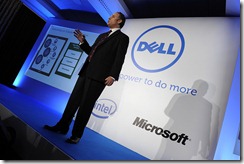Many customers have difficulty taking virtualization to the next, more productive level. They’re stuck at 20 percent when they know that the real benefits are achieved when more than 45 percent of their environment is virtualized. Why? They’ve hit the ‘virtual ceiling’, caused by management and deployment complexities, cost constraints and the need to spend time and resources just keeping the infrastructure running rather than developing new ways to deliver IT as a Service.

Dell’s Bryan Jones at #SSVE London announcing our Dell Microsoft Management and Virtualization Solutions Partnership
Today, I am happy to announce the Dell|Microsoft Management and Virtualization Solutions Partnership. We are partnering specifically to change the economics and enable customers to reach the next, more beneficial state of virtualization – to effectively break through the virtual ceiling. Together, Dell and Microsoft can help you simplify management and improve efficiency with integrated management solutions comprised of the Dell Virtual Integrated System, Dell Advanced Infrastructure Manager (AIM) and Microsoft System Center . Virtualization solutions will be based on Microsoft Windows Server 2008 Hyper-V, which delivers strong workload performance and low total cost of ownership.
It’s recognized that the adoption of a multiple hypervisor strategy is both necessary and inevitable as customers virtualize greater portions of their data center. Our new approach and strategy will:
- Lower costs: virtualize more by applying the right hypervisor to the right workload
- Improve performance: route workloads to the hypervisor that works best Add flexibility: provide more choices and options – today and in the future – with no vendor lock in
- Lower risk and improve speed-to-deployment by leveraging existing knowledge, skills and infrastructure
The case of remote offices offers a way to demonstrate the benefits of this approach. Using Dell VIS and AIM, virtualization can be readily extended to all server locations, without the need for technical staff in these remote offices. Dell AIM abstracts the workloads from the hardware enabling customers to change the workload running on their servers (physical or virtual), and its connectivity to the network and storage within the span of a reboot. This can significantly reduce operation and infrastructure cost.
For more information on the joint solution, read “Extending virtualized environments with multiple-hypervisor management.”
Follow the conversations on Twitter about today’s announcements via #SSVE and check out the photos and videos from our events in Beijing, San Francisco and London on Flickr.